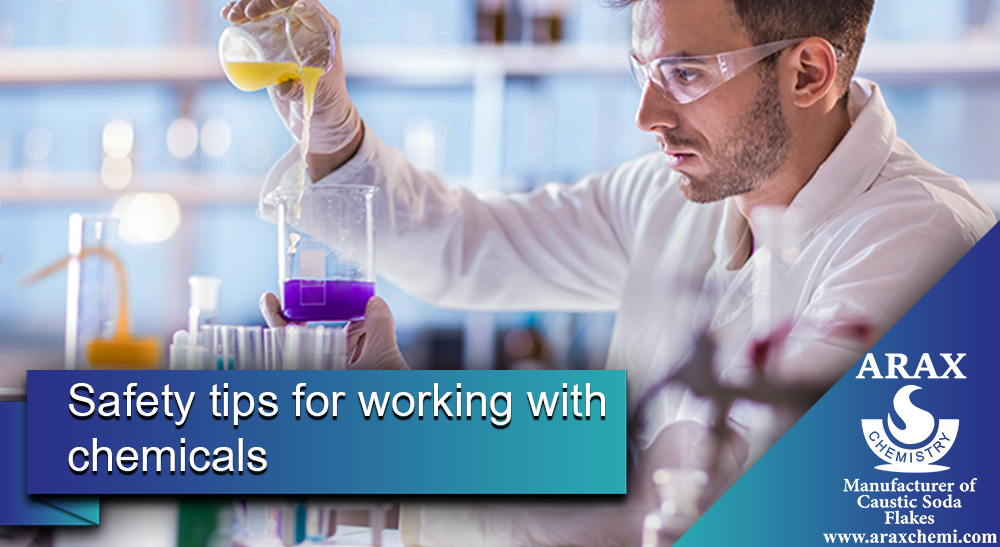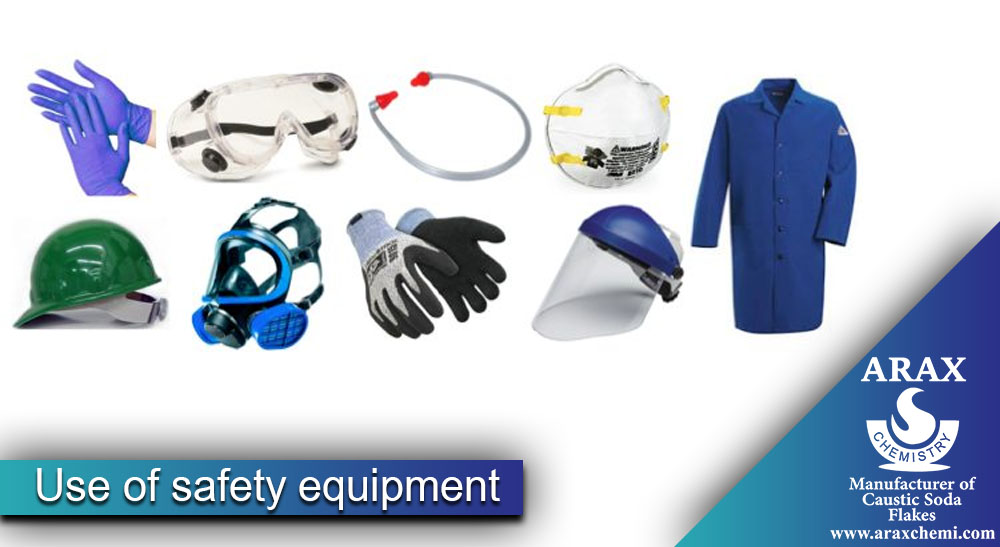Safety tips for working with chemicals (alkaline)
Working with alkaline chemicals can be fundamental in many industries and economic activities. These materials, with their special characteristics, can be used in the production of products, cleaning, water treatment, disease treatment and other industrial and scientific processes. However, working with alkaline chemicals is associated with serious risks and damages to people’s health and safety. These chemicals can cause serious damage to the skin, eyes, breathing, and even if swallowed. Some of the famous alkaline chemicals are caustic soda (sodium hydroxide), ammonia and potassium hydroxide.
In this article, we will discuss safety in working with alkaline chemicals. We discuss the benefits and importance of safety in working with these materials, the risks and harms associated with them, safety principles and methods, and other important things that must be considered to maintain health and safety in this field. By reading this article, you can learn the best methods and safety strategies in working with alkaline chemicals and reduce possible risks.
What are alkaline substances?
Alkaline substances are chemicals that have alkaline properties, i.e. high pH. They are able to produce hydroxide ions (OH-) in solutions and react with acids. Alkaline substances are usually chemical compounds that include elements such as sodium (Na), potassium (K), calcium (Ca) and iron (Fe).
Some of the known alkaline substances are:
- Sodium Hydroxide: This substance is known as caustic soda with the formula NaOH.
- Potassium Hydroxide (Potassium Hydroxide): which is known by the formula KOH and is also known as potassium hydroxide.
- Calcium hydroxide: This chemical compound is known with the chemical formula Ca(OH)2 and is also known as quicklime.
- Ammonia: NH3, which is a non-metallic compound and is considered as an alkaline substance.
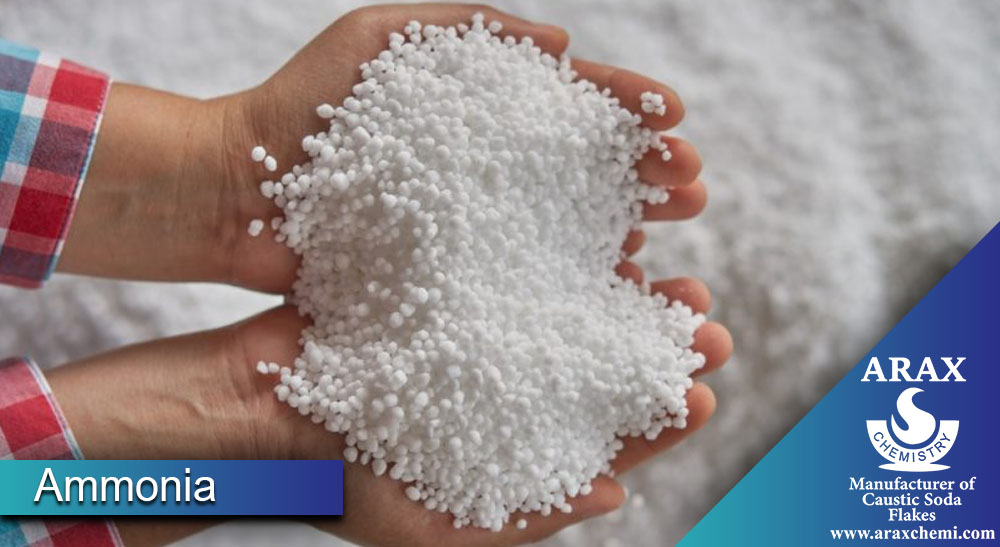
Alkalis are used in many industries, including soap production, detergents, degreasing, food industry, pharmaceutical industry and others. Also, some alkaline substances can be used directly in household use and as detergents and degreasers.
Safety tips in working with alkaline chemicals
Working with alkaline chemicals can bring certain risks. In general, the important points of working with chemicals include: skin and eye protection, proper ventilation, use of protective equipment, proper storage, washing operations and fire extinguishing, among the important safety points in the use of alkaline chemicals. In this article, we will review these issues, stay with us.
- Familiarity with chemical properties
- Use of safety equipment
- Proper ventilation
- Avoid direct contact
- Cooperation in case of accidents
- Training and awareness of employees
Familiarity with the properties of chemicals
Chemical properties refer to the characteristics and behaviors that define them in interaction with other substances. Below I mention some properties of chemicals:

-
pH:
is a measure that shows the acidity or alkalinity of a solution. A pH less than 7 means that the solution is acidic and a pH greater than 7 means that the solution is alkaline.
-
Oxidity and reduction:
some substances are able to accept or donate electrons from them in reaction with other substances. Substances that donate electrons are known as reducing agents and substances that accept electrons are known as oxidizing agents.
-
Repairability:
some materials are able to repair and restore damage and chemical changes. Normally, this property is observed in liquid state and polymers.
-
Thermochemistry:
Some substances are able to generate heat during chemical reactions. This property can be used in processes such as combustion and energy production.
-
Toxic effects:
Some substances are capable of producing toxic effects in humans and other organisms. This property can cause serious risks to people’s health and safety.
-
Solubility:
Some substances are able to dissolve in other solutions. This property can be used in extraction and purification processes.
-
Color:
Some materials are able to absorb light and reflect it, and that’s why they have color. This property can be used in the detection and identification of materials.
These are just a few examples of the chemical properties of substances, and each substance can have its own unique properties that depend on its chemical composition and structure.
Use of safety equipment
It is very important to use proper safety equipment to protect against alkaline substances. In the following, we discuss the safety equipment used in working with alkaline substances.
-
Gloves:
It is mandatory to use gloves resistant to alkali substances. Gloves made of latex, nylon, nitrile, and leather materials can provide adequate protection against direct contact with alkalis.
-
Protective glasses:
It is necessary to use protective glasses with the ability to resist alkali substances to protect the eyes. These glasses should have features such as protection against drops and splashes of alkaline substances.
-
Clothes and covers:
Wearing suitable protective clothes and covers can prevent the direct contact of alkaline substances with the skin. Clothing that is resistant to chemicals and covers the entire body, and is made of synthetic leather, polymers, and PVC, is suitable for body protection.
-
Breathing masks:
If proper ventilation is not possible in the work environment or you are exposed to vapors and alkaline particles, it is necessary to use breathing masks. Breathing masks with chemical filters are able to remove particles and alkaline vapors from the air and help protect the lungs and respiratory system.
-
Education and awareness:
You should always follow the instructions and guidelines of the supplier of alkaline materials and familiarize yourself with the risks associated with them. These instructions are available to consumers in the Material Safety Data Sheet (MSDS). This sheet includes relevant training for the safe use of alkaline substances, knowing their properties and dangers, the correct methods of storing and disposing of alkaline substances.
What is an MSDS?
MSDS stands for Material Safety Data Sheets. These sheets contain chemical information, hazards and safety measures of chemicals.
In the MSDS sheet, the chemical information includes the name, chemical formula, degree of purity, molecular weight, boiling point and melting point, pH, dielectric constant and the temperature range in which the substance is stable.
Also, this instruction includes hazard information such as toxicity, flammability, explosion, leakage, and fire potential for human health, the environment, and material safety.
In addition, the MSDS sheet includes any safety precautions that must be followed when using the chemical. These measures include correct use, use of personal protective equipment, air conditioning, safe storage, fire extinguishing methods and behavior in the face of accidents.
Proper ventilation
Proper ventilation when using chemicals is very important to maintain your health and safety. Always follow the instructions and guidance of chemical suppliers and consult relevant experts if needed. Below, we review important tips for proper ventilation in these cases:
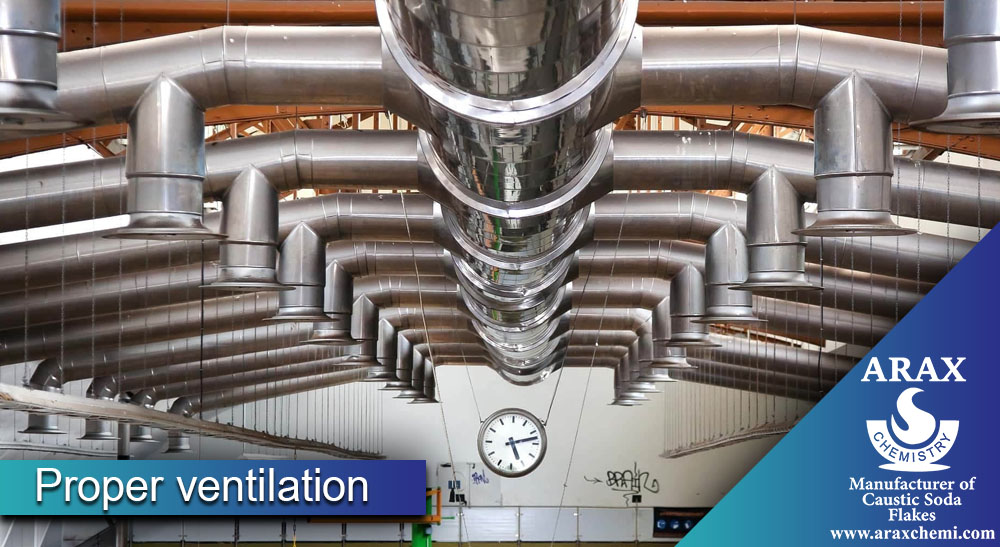
-
Ensuring proper ventilation of the work environment:
Make sure that your work environment has a proper ventilation system. Proper ventilation system includes mechanisms such as air conditioning system, extractors, hoods and ventilation fans that can remove gases, vapors and chemical particles from the work environment.
-
Use of hoods and extractors:
If you work with chemicals in a closed environment, you must use hoods and extractors. These equipments are able to absorb and remove vapors and chemical gases from the environment and provide cleaner air.
-
Limit the contact of materials with air:
try to use chemicals in an open and well-ventilated area. This can stop the release of chemical vapors into the air and reduce the risks.
-
Create mechanical ventilation if needed:
In case of ventilation not working properly, it may be necessary to activate the mechanical ventilation system near the workplace to inject clean air into the environment and remove polluted air from the environment.
-
Monitoring and measuring:
When you work with chemicals, using monitoring and measuring equipment can be useful. This equipment includes sensors and devices such as gas meters and devices for measuring the concentration of chemicals in the air. Using this equipment, you can monitor the level of air pollution and take corrective measures if necessary.
Avoid direct contact
We examine safety in direct contact with chemicals in 5 cases.
-
Use of protective equipment:
Be sure to use personal protective equipment, including protective gloves, protective glasses, and protective clothing. These devices can prevent direct contact of skin, eyes and clothes with chemicals.
-
Immediate washing:
In case of direct skin contact with chemicals, immediately wash the contact area with plenty of water. It is recommended to use mild running water to wash the contact area. In more severe cases, you can use an emergency shower.
-
Do not use corrosive substances:
Never use corrosive substances such as acids to clean chemicals. This action may cause more dangerous chemical reactions.
-
Detailed information about the materials:
As we mentioned in this article, before using or dealing with chemicals, be sure to get detailed information about their properties and dangers. Read the ingredients’ labels, instructions, and directions. This information will help you handle chemicals properly.
-
Contact a doctor:
In case of an accident and direct skin or eye contact with chemicals, contact a doctor or poison center immediately. They can provide the necessary guidance and diagnose the appropriate treatment.
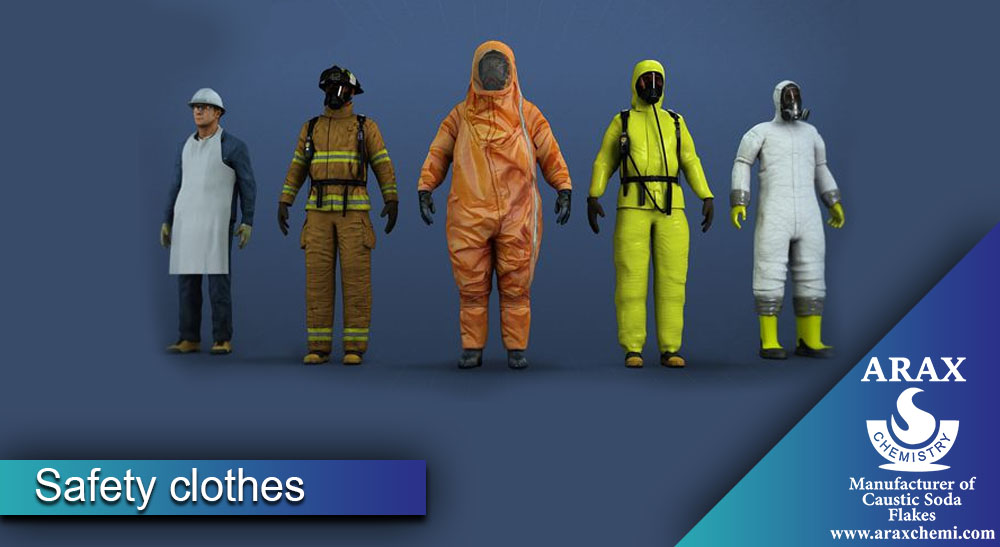
-
Safety clothes:
Protective clothes against alkaline chemicals play an important role in protecting the body against possible dangers. Below, I mention some features of protective clothing against alkaline chemicals:
-
Chemical resistance:
protective clothing to deal with alkaline chemicals must have a suitable chemical resistance. They must be able to provide resistance to the penetration and impact of alkaline chemicals.
-
Low absorption and penetration:
protective clothing should be able to minimize the absorption and penetration of chemicals. This feature prevents alkaline chemicals from being quickly absorbed and penetrating your body in contact with clothes.
-
Skin protection:
Protective clothing should be able to protect the skin against alkaline chemicals. They must have a suitable structure that separates the skin from direct contact with chemicals and prevents the possibility of damage and chemical burns to the skin.
-
Ease of use:
Protective clothing should be comfortable and usable, so that users can wear it properly and have the necessary comfort during use.

-
Safety standards:
When choosing protective clothing, pay attention to the relevant safety standards. Wearing clothing that meets the relevant safety standards will ensure that you are exposed to fewer risks.
The importance of using protective clothing against alkaline chemicals is very high and to protect your health and personal safety, it is recommended to use these clothes in the relevant environments.
Direct contact with chemicals, especially alkalis, can be dangerous. You can reduce the possible risks of direct contact with alkaline chemicals by using protective equipment, washing immediately, not using corrosive substances, having accurate information and calling a doctor if necessary.
Cooperation in case of accidents
Cooperation in the event of incidents related to chemicals is very important and can play an important role in reducing risks and maintaining people’s health and safety. Below, I provide explanations about cooperation in such cases:
-
Notification of an accident:
In case of an accident related to chemicals, immediately report the incident to the relevant officials and authorities. These authorities may include the safety team, emergency management or poison control center. Accurate and timely notification of the incident helps in faster safety measures and better control of the incident.
-
Emergency Instructions:
Familiarize yourself with emergency instructions and protocols for chemical incidents. These guidelines include guidance on safety, awareness of chemical hazards, and fire control and extinguishing methods. Following these instructions in times of crisis can prevent life-threatening situations.

-
Cooperation with safety and emergency teams:
In case of a chemical accident, cooperation with safety and emergency teams is very important. Informing the relevant teams and cooperating in the event of chemical incidents is very important and can play an important role in reducing risks and maintaining people’s health and safety.
Training and awareness of employees
Training employees and raising their awareness about working with chemicals is vital. Because these trainings prepare employees to identify risks, use chemicals correctly, and react appropriately in the face of accidents. In the following, we examine the things that should be considered in a complete training:
-
Chemical Identification:
Employees must have the ability to identify chemicals, which includes recognizing symbols, labels, and Material Safety Data Sheets (MSDS). Employees must be able to distinguish hazardous substances from non-hazardous substances and be familiar with the characteristics and risks associated with each substance.
-
Safe use of chemicals:
Employees must receive the necessary training to be able to work with chemicals correctly and safely. These trainings include how to work with chemicals, transfer, store and dispose of chemicals. Also, employees should be familiar with the use of personal protective equipment such as protective gloves, goggles, and respirators.
-
Behavior in the face of accidents:
Trainings related to the behavior in the face of chemical accidents are very important. Employees must know how to act in the event of an accident, report the incident and implement basic safety measures. These trainings should include fire control, fire fighting, schizophrenia, and transportation of hazardous materials.

-
Access to safety information:
Employees should be able to easily access material safety information. Training should demonstrate how to read and use Material Safety Data Sheets (MSDS). This information includes physical and chemical properties, hazards, safety measures and emergency procedures.
-
Emergency training:
Employees must receive emergency training in the face of chemical accidents. These trainings include chemical spills, explosions and basic duties in case of these incidents. Employees must know how to properly and safely pass through danger rooms and restricted areas and move to safe places.
-
Equipment and tools training:
Employees should be familiar with the equipment and tools used in working with chemicals. Training should include how to use, adjust, troubleshoot and maintain this equipment. Also, training on safety equipment such as fire extinguishers and ventilation devices is also necessary.
-
Communication and coordination training:
If many people deal with chemicals in the workplace, communication and coordination training is very important. which includes teaching the correct use of radios, emergency phones and other communication systems. Employees must know how to correctly send and receive information and help each other in case of incidents.
-
Crisis planning and management:
Crisis planning and management training helps employees to react quickly and efficiently in case of chemical accidents. These trainings include determining emergency contact points, forming emergency teams and practical exercises.
-
Health and safety training:
Employees must be trained in the health and safety of the workshop and have the necessary knowledge about issues related to chemical safety. which includes training on the diagnosis and prevention of health complications caused by chemicals, unwanted pollution control and implementation of health standards.
Security measures against chemical incidents
In case of accidents related to chemicals, you should take the following necessary actions:
1. Incident notification:
Immediately notify the safety and operation authorities at your workplace. You can use alarm, telephone, wireless or other necessary means of communication for this communication.
2. Return to the safe environment:
Leave the area immediately and return to a well-ventilated area away from any danger. This will help you avoid further exposure to chemicals.
3. Self-protection:
Take protective measures depending on the amount of contact with chemicals. For example, upon contact with skin, eyes, or face, flush the area immediately with water. If necessary, see a doctor and follow the doctor’s recommendations.
4. Fire extinguishing:
In case of fire, use proper fire extinguishing methods. If the fire is small, you can use water or an approved type of fire extinguisher. In the event of a larger fire, immediately activate the fire alarm and call for assistance from professional fire officials.
5. Access restrictions:
Make sure no one gets close to the accident area and restrict access there. This action helps prevent the possibility of spreading the incident to other people.
6. Incident report:
Immediately after the incident, report it to the relevant authorities. You must report the details of the incident accurately and correctly so that they can take the necessary actions and conduct the necessary investigations to prevent the recurrence of similar incidents.
7. Retraining:
After an incident, it is essential to review and train your employees and co-workers. Investigating the causes of the accident, providing the necessary explanations and updating the safety standards and methods related to chemicals are necessary to prevent the recurrence of similar accidents.
Conclusion
Since working with alkaline chemicals carries many risks, safety in working with these materials is very important. Paying attention to safety principles and methods in working with alkaline chemicals can help maintain health and prevent accidents and serious injuries. Some of the things that should be considered in terms of safety in working with alkaline chemicals are: use of personal protective equipment such as glasses, protective clothing, chemical gloves and respirators, reading and following the Material Safety Data Sheet (MSDS), instructions for use Provided by the chemical manufacturer, proper storage and maintenance of chemicals in appropriate and separate environments, training of employees on the properties and hazards of alkaline chemicals, and appropriate planning for response to potential accidents and injuries. This article was a compilation of safety information about alkaline chemicals.
